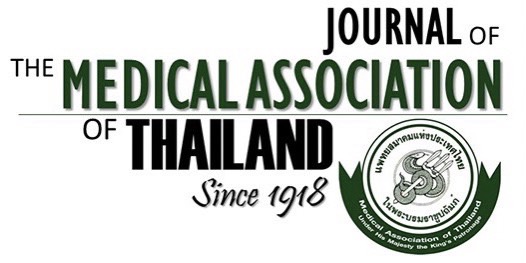Combination of Acute Stroke Unit and Short-Term Stroke Ward with Early Supported Discharge Decreases Mortality and Complications after Acute Ischemic Stroke
Nijasri Charnnarong Suwanwela MD*, Nattapong Eusattasak MD*, Kammant Phanthumchinda MD*, Krisna Piravej MD**, Chaichon Locharoenkul MD*
Affiliation : * Neurological Unit, Department of Medicine, Faculty of Medicine, Chulalongkorn University ** Department of Physical Medicine and Rehabilitation, Faculty of Medicine, Chulalongkorn University
Background : The stroke unit has been established as a standard care for stroke. However, it has not been
widely established in developing countries due to the lack of understanding and limited resources.
Objective : To compare the complications and mortality of stroke patients admitted in the stroke unit and
short-term ward with those admitted in the general medical ward.
Materials and Methods : The authors prospectively collected data of acute stroke patients who were admitted
after the set up of the stroke unit and stroke short-term ward in 2003, and compared with the data of those who
were admitted in a general medical ward in 2001. All acute stroke patients who presented within seven days
of the onset were admitted and those who had final diagnosis of ischemic stroke or transient ischemic attack
(TIA) were studied. Patients in the stroke unit were taken care of by a multidisciplinary team approach under
clinical guidelines and a care map. The short-term ward is a part of the general medical ward and stroke
patients were treated by a multidisciplinary team followed by homecare treatment. The endpoints were mor-
tality rate, neurological and medical complications during admissions, and the mean length of stay.
Results : Seven hundred and ninety-four patients were studied. Three hundred and eighty-seven patients were
admitted in 2001 and 407 patients in 2003. Among patients presented 2003, three hundred and one cases
were treated in the acute stroke unit whereas 106 were admitted in the short-term ward. There was no
difference in stroke risk factors and stroke subtypes between the two groups, except for dyslipidemia and
cigarette smoking, which were more prevalent in patients admitted in 2003. Patients in the stroke unit and the
short-term ward had significantly less mortality than those in the general medical ward (8.9 and 2.1%).
Overall complications in the stroke unit and the short-term ward were 16.8%, compared to 26% of those
admitted into the general medical ward. Significantly less brain edema, hemorrhagic infarction, urinary tract
infection, pneumonia, and pressure sore were also observed. The length of hospital stay of the patients
admitted in 2001 and 2003 was 11.26 and 8.09 days, respectively.
Conclusion : Combination of organized acute stroke unit and short-term ward with early supported discharge
reduces the mortality and complications of ischemic stroke patients during admission as well as the length of
stay when compared to the general medical ward. The present study reassures that the combination is useful
for hospitals in developing countries, which have limited number of beds in their stroke units.
Keywords : Stroke Unit, Complications, Acute ischemic stroke, Early supported discharge



